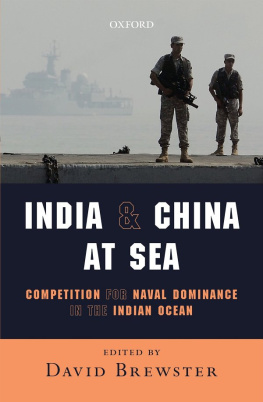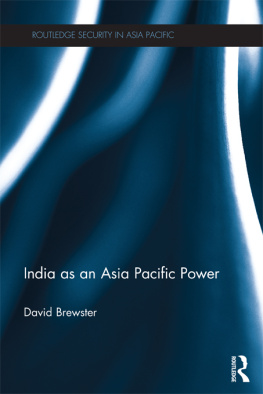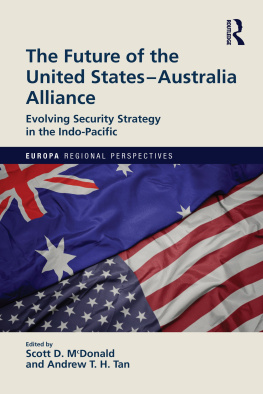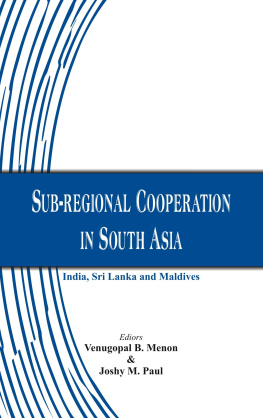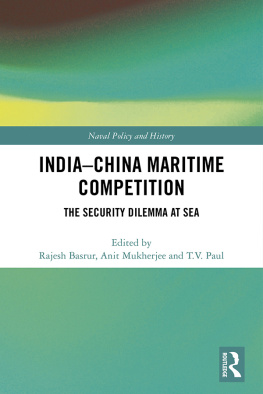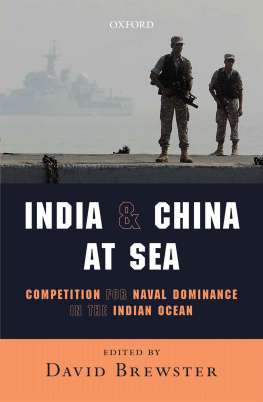India and China at Sea
David Brewster hits the mark, yet again, with this topical anthology, offering incisive insights into ongoing strategic developments in the Indian Ocean; where delusional superpower, China faces off against apprehensive neighbour, India.
An eclectic selection of analysts present the reader with fascinating nuances of the maritime Great Game in progress; and leave him wondering if it will all end in tame capitulation (to an emerging hegemon) or dramatic dnouement (on the high seas)?
Admiral Arun Prakash, former Chief of Naval Staff,
Indian Navy
I have long argued that the ChinaIndia maritime rivalry will be a defining feature of geopolitics in the twenty-first century. As Chinas navy goes south to the Indian Ocean, Indias navy is going east to the Pacific. This very timely volume on India and China at Sea, with thought-provoking papers from several distinguished scholars and analysts from Australia, China, India, and the United States, makes an invaluable contribution to our understanding of the maritime ambitions and strategies of Asias rising powers and the complex maritime security challenges facing all sea-faring nationsbig and small. A must read for practitioners, policymakers, media persons, academics, and students of international affairs.
J. Mohan Malik, Professor of Asian Security,
Asia-Pacific Center for Security Studies, Honolulu
India and China at Sea
Competition for Naval Dominance in the Indian Ocean
edited by
David Brewster


Oxford University Press is a department of the University of Oxford.
It furthers the Universitys objective of excellence in research, scholarship,
and education by publishing worldwide. Oxford is a registered trademark of
Oxford University Press in the UK and in certain other countries.
Published in India by
Oxford University Press
2/11 Ground Floor, Ansari Road, Daryaganj, New Delhi 110 002, India
Oxford University Press 2018
The moral rights of the authors have been asserted.
First Edition published in 2018
All rights reserved. No part of this publication may be reproduced, stored in
a retrieval system, or transmitted, in any form or by any means, without the
prior permission in writing of Oxford University Press, or as expressly permitted
by law, by licence, or under terms agreed with the appropriate reprographics
rights organization. Enquiries concerning reproduction outside the scope of the
above should be sent to the Rights Department, Oxford University Press, at the
address above.
You must not circulate this work in any other form
and you must impose this same condition on any acquirer.
ISBN-13 (print edition): 978-0-19-947933-7
ISBN-10 (print edition): 0-19-947933-X
ISBN-13 (eBook): 978-0-19-909168-3
ISBN-10 (eBook): 0-19-909168-4
Typeset in Adobe Garamond Pro 11/13
by The Graphics Solution, New Delhi 110 092
Printed in India by Replika Press Pvt. Ltd
Thanks to Christine, Jack, Juliette, Bronte, Essie,
and Artie for their patience, support,
and editorial assistance
Contents
David Brewster
Jingdong Yuan
Pramit Pal Chaudhuri
John Garver
You Ji
Srikanth Kondapalli
Raja Menon
Iskander Rehman
Darshana M. Baruah
Abhijit Singh
Zhu Li
Jabin T. Jacob
Rory Medcalf
This book is the outcome of a project undertaken by the Australia India Institute, University of Melbourne, with the generous support of the John D. and Catherine T. MacArthur Foundation.
| ADIZ | Air Defence Identification Zone |
| ANI | Andaman and Nicobar Islands |
| ASCMs | anti-ship cruise missiles |
| ASW | anti-submarine warfare |
| ASUW | anti-surface warfare |
| ASEAN | Association of Southeast Asian Nations |
| AWACS | Airborne Warning and Control System |
| AUSINDEX | IndiaAustralia biennial exercises |
| BCIM | BangladeshChinaIndiaMyanmar |
| BCIM-EC | BangladeshChinaIndiaMyanmar Economic Corridor |
| BECA | Basic Exchange and Cooperation Agreement |
| CNA | Center for Naval Analyse |
| CSG | carrier strike group |
| CPEC | ChinaPakistan Economic Corridor |
| CUES | Code for Unplanned Encounters at Sea |
| CISMOA | Communications and Information Security Memorandum of Agreement |
| DPP | Democratic Progressive Party |
| EEZ | Exclusive Economic Zone |
| EAMF | Expanded ASEAN Maritime Forum |
| HADR | humanitarian assistance and disaster relief |
| IMAC | Information Management and Analysis Centre |
| IOR | Indian Ocean Region |
| IORA | Indian Ocean Rim Association |
| ISLs | International Shipping Lanes |
| JMSDF | Japanese Maritime Self Defence Forces |
| LAC | lines of actual control |
| LACMs | land attack cruise missiles |
| LPDs | Landing Platform Docks |
| LEMOA | Logistics Exchange Memorandum of Agreement |
| LSA | Logistics Support Agreement |
| MCMVs | mine countermeasure vessels |
| MDA | maritime domain awareness |
| MSR | Maritime Silk Route |
| MOD | Ministry of Defence |
| MPA | maritime patrol aircraft |
| SSNs | nuclear attack submarines |
| OBOR | One Belt One Road |
| PLA | Peoples Liberation Army |
| PLAN | Peoples Liberation Army Navy |
| RFI | Request for Information |
| SLOCs | sea lines of communication |
| SIMBEX | SingaporeIndia annual maritime exercises |
| SOF | Special Operations Forces |
| SSBNs | ballistic missile nuclear submarines |
| SSKs | diesel-electric submarines |
| TELs | Transporter Erector Launchers |
| UUVs | unmanned underwater vehicles |
| USMC | US Marine Corps |
| VLS | vertical launch systems |
| VLCC | very large crude carriers |
| WTO | World Trade Organization |
China and India are fast emerging as major maritime powers of the Indo-Pacific. As their wealth, power, and interests expand, they are increasingly coming into contact with each other in the maritime domain. How India and China get along in the shared Indo-Pacific maritime spacecooperation, coexistence, competition, or confrontationmay be one of the key strategic challenges for the region in the twenty-first century. The relationship between these powers is sometimes a difficult one: in particular, their security relationship is relatively volatile and there are numerous unresolved issues. Not least is Chinas growing presence in the Indian Ocean where it is perceived in New Delhi to be shaping the strategic environment and forming alignments that could be used against India.
Next page
